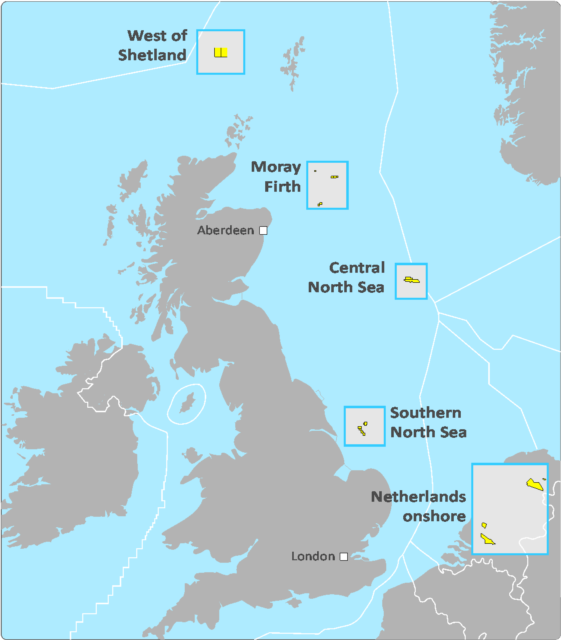Parkmead, the UK and Netherlands-focused independent energy group, announces that a draft Field Development Plan ("FDP") and Environmental Statement ("ES") for the Platypus gas project has been submitted to the Oil and Gas Authority ("OGA") and the Offshore Petroleum Regulator for Environment and Decommissioning ("OPRED"), respectively.

Parkmead assets in UK and Netherlands (Image source: KeyFacts Energy)
These two documents were submitted on behalf of the co-venturers by Dana Petroleum, a subsidiary of the Korean National Oil Corporation (KNOC). Parkmead's co-venturers in the Platypus project are CalEnergy Gas (15%), Zennor Petroleum (11%) and Dana Petroleum (59%). Parkmead's equity in the project is 15%.
HIGHLIGHTS
- Draft Field Development Plan and Environmental Statement submitted to the OGA and OPRED, respectively, for the development of the Platypus gas project in the UK Southern North Sea
- Selected development concept is a subsea tie-back to the Cleeton platform, significantly reducing initial capital expenditure and field operating cost
- Gas will be exported from Platypus to Cleeton via a 23km pipeline before being routed directly to the Dimlington terminal for separation and processing
- Mid case technical recoverable reserves from Platypus of 105 billion cubic feet ("Bcf")
- Platypus East (previously Possum) provides significant upside to the Platypus project, potentially adding up to 51 Bcf of reserves to the project
- Platypus East is estimated by the operator to have a Geological probability of success (GPos) of 73%
- Platypus alone is expected to produce 47 million cubic feet of gas per day ("MMscfd") at peak production, according to operator estimates
- The anticipated producing life of the field is approximately 20 years
- Platypus was flow tested in 2012, following a successful appraisal well, at a rate of 27 MMscfd (approximately 4,600 barrels of oil per day on an equivalent basis).
Summary of the Project
The Platypus field is located in the UK Southern North Sea in Blocks 47/5b and 48/1a, approximately 18 km north west of the West Sole gas field and 15 km south west of the Babbage field. The Platypus gas field was discovered in 2010 and was successfully appraised with a horizontal well in 2012 which was flow tested at a rate of 27 million cubic feet of gas per day (approximately 4,600 barrels of oil per day on an equivalent basis).
As a result of the successful appraisal well, the field development studies have been progressed leading to confirmation of concept selection and submission of the draft development plan. The draft Field Development Plan and Environmental Statement are subject to the standard regulatory review and approvals.
The selected development concept will consist of two development wells connected to a subsea manifold, with gas export to the Cleeton Wellhead (CW) platform via a 23km pipeline. Controls will be provided from Cleeton via a subsea control umbilical that will be installed along with the pipeline. Produced fluids will arrive at the Cleeton facilities before being routed directly to the Dimlington Terminal for separation and processing.
The Perenco-operated Cleeton CW platform is bridge-linked to the manned Cleeton CP platform. The other installations and gas fields connected to Cleeton are Ravenspurn, Neptune, Minerva, Wollaston and Whittle.
The development option selected for the Platypus field was reached following an extensive concept selection process. This considered technical feasibility, project execution schedule and commercial viability, in addition to environmental, health and safety issues.
Several existing offshore facilities were considered as hosts for the processing and export of the Platypus fluids. The Cleeton CW platform and onward transport to the Dimlington onshore terminal provided the optimal combination of technical, commercial and environmental options and was therefore selected as the preferred development option.
Tenders for the Subsea Pipeline & Facilities Engineering, Procurement, Construction and Installation, the Umbilical Supply and Controls Supply are all planned to be issued during Q4 2019. Project Sanction is expected to occur in Q2 2020 with First Gas scheduled in Q1 2022.
The two Platypus development wells, of similar design, will be drilled to approximately 3,109 m (10,200 feet). The water depth at the proposed Platypus well location is approximately 40m.
Platypus East provides a significant upside opportunity for the project, potentially adding another 51 Bcf of recoverable reserves. It is planned that early reservoir monitoring will be conducted at Platypus in order to gather additional data prior to the drilling of Platypus East.
Tom Cross, Executive Chairman, commented:
"We have achieved an important milestone on the valuable Platypus project. This innovative subsea tie-back plan reduces the cost of the project significantly.
The Platypus project has the potential to open up further development upside in this prolific gas area, in which Parkmead has additional appraisal and exploration interests.
Platypus is a key element within Parkmead's growing and balanced energy portfolio. This includes low-cost onshore Dutch gas production and a number of exciting development projects, including the Greater Perth oil Area.
Parkmead is also working hard to evaluate its range of high-quality oil & gas exploration licences and a number of renewable energy opportunities available to the Company".
 KEYFACT Energy
KEYFACT Energy